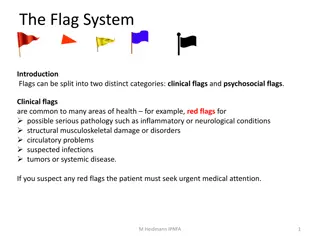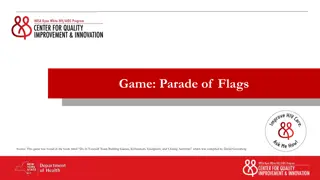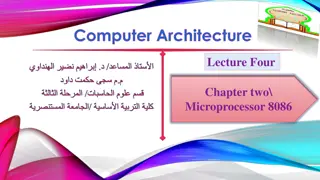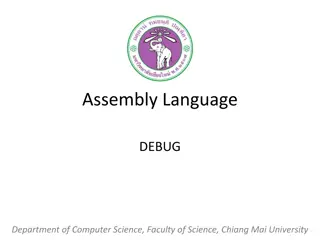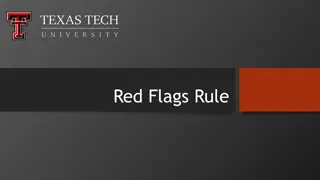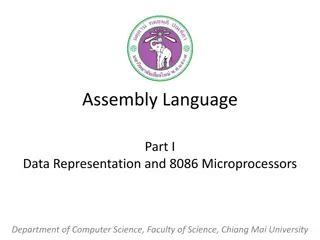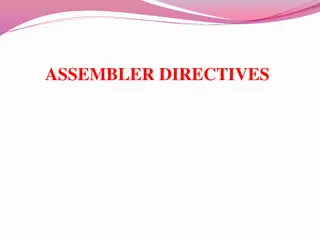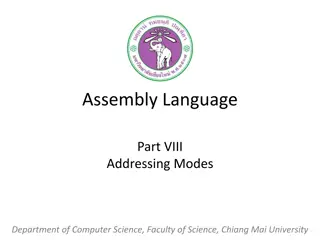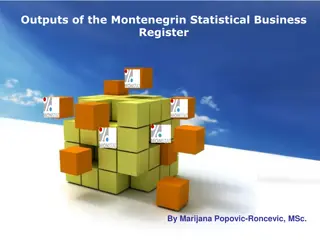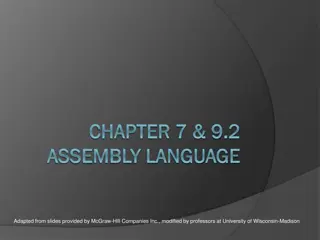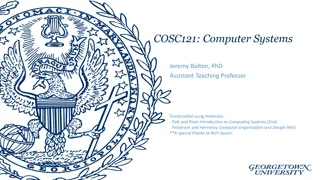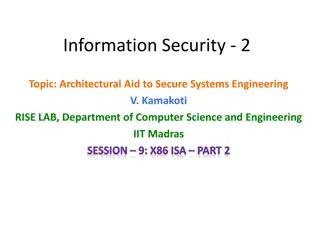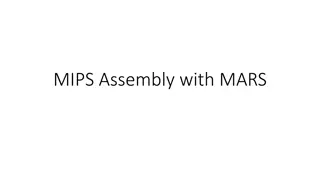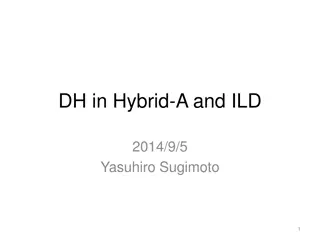Understanding the FLAGS Register in Assembly Language
An exploration of the FLAGS register in assembly language, highlighting the key status flags such as Carry Flag (CF), Parity Flag (PF), Auxiliary Carry Flag (AF), Zero Flag (ZF), Sign Flag (SF), and Overflow Flag (OF). These flags play a crucial role in reflecting the outcome of operations within the processor and are essential for handling different types of arithmetic and logical instructions.
Uploaded on Jul 19, 2024 | 1 Views
Download Presentation

Please find below an Image/Link to download the presentation.
The content on the website is provided AS IS for your information and personal use only. It may not be sold, licensed, or shared on other websites without obtaining consent from the author. Download presentation by click this link. If you encounter any issues during the download, it is possible that the publisher has removed the file from their server.
E N D
Presentation Transcript
Assembly Language Part IV The FLAGS Register Department of Computer Science, Faculty of Science, Chiang Mai University
Outline The FLAGS Register Overflow How Instruction Affect the Flags 2 204231: Computer Organization and Architecture
FLAGS 3 204231: Computer Organization and Architecture
The Status Flags The processor uses the status flags to reflect the result of an operation. The status flags are located in bits 0, 2, 4, 6, 7, and 11. 4 204231: Computer Organization and Architecture
Carry Flag (CF) CF = 1 if there is a carry out of msb on addition, or there is a borrow into msb on subtraction; otherwise, CF = 0. 5 204231: Computer Organization and Architecture
Parity Flag (PF) PF = 1 if the low byte of a result has an even number of one bits (even parity). PF = 0 if the low byte has odd parity. 6 204231: Computer Organization and Architecture
Auxiliary Carry Flag (AF) AF = 1 if there is a carry out from bit 3 on addition, or a borrow into bit 3 on subtraction. 7 204231: Computer Organization and Architecture
Zero Flag (ZF) ZF = 1 for a zero result. ZF = 0 for a nonzero result. 8 204231: Computer Organization and Architecture
Sign Flag (SF) SF = 1 if the msb of a result is 1; it means the result is negative if you are giving a signed interpretation. SF = 0 if the msb is 0. SF = MSB 9 204231: Computer Organization and Architecture
Overflow Flag (OF) OF = 1 if signed overflow occurred, otherwise OF = 0. 10 204231: Computer Organization and Architecture
Decimal Range UNSIGN [0, 255] [0, 65535] SIGN [-128, 127] [-32768, 32767] BYTE WORD 11 204231: Computer Organization and Architecture
Overflow No Overflow Signed Overflow Only Unsinged Overflow Only Both Overflows 12 204231: Computer Organization and Architecture
The Example of Unsigned Overflow ADD AX, BX 1111 1111 1111 1111 65535 AX = FFFFh + 0000 0000 0000 0001 1 0000 0000 0000 0000 00000 AX = 0000h 1 BX = 0001h 1 0000 0000 0000 0000 = 65536 > 65535 13 204231: Computer Organization and Architecture
The Example of Signed Overflow ADD AX, BX 0111 1111 1111 1111 32767 AX = 7FFFh + 0111 1111 1111 1111 32767 BX = 7FFFh 1111 1111 1111 1110 -2 AX = FFFEh 32767 + 32767 = 65534 <> -2 14 204231: Computer Organization and Architecture
How the Processor Determines that Unsigned Overflow Occurred CF = 1 Addition There is a carry out of the msb. The correct answer is larger than the biggest unsigned number (FFFFh and FFh). Subtraction There is a borrow into the msb. The correct answer is smaller than 0. 15 204231: Computer Organization and Architecture
How the Processor Determines that Signed Overflow Occurred OF = 1 There is a carry into the msb but no carry out. There is a carry out but no carry in. Addition The sum has a different sign. Subtraction The result has a different sign than expected. A ( B) = A + B A (+B) = A + B Addition of Numbers with Different Signs Overflow is impossible. A + ( B) = A B 16 204231: Computer Organization and Architecture
How Instructions Affect the Flags Instruction MOV/XCHG ADD/SUB INC/DEC NEG Affects Flags none all all except CF all (CF = 1 unless result is 0, OF = 1 if word operand is 8000h, or byte operand is 80h) 17 204231: Computer Organization and Architecture
ADD AX, BX where AX contains FFFFh and BX contains FFFFh. FFFFh + FFFFh 1 FFFEh 1111 1111 1111 1111 + 1111 1111 1111 1111 1 1111 1111 1111 1110 AX = FFFEh SF = 1 because the msb is 1. PF = 0 because there are 7 (odd number) of 1 bits in the low byte of the result. ZF = 0 because the result is nonzero. CF = 1 because there is a carry out of the msb on addition. OF = 0 because the sign of the stored result is the same as that of the numbers being added (as a binary addition, there is a carry into the msb and also a carry out). 18 204231: Computer Organization and Architecture
ADD AL, BL where AL contains 80h and BL contains 80h. 80h 1000 0000 + 1000 0000 1 0000 0000 + 80h 1 00h AL = 00h SF = 0 because the msb is 0. PF = 1 because all the bits in the result are 0. ZF = 1 because the result is 0. CF = 1 because there is a carry out of the msb on addition. OF = 1 because the numbers being added are both negative, but the result is 0 (as a binary addition, there is no carry into the msb but there is a carry out). 19 204231: Computer Organization and Architecture
SUB AX, BX where AX contains 8000h and BX contains 0001h. 8000h 0001h 7FFFh 1000 0000 0000 0000 0000 0000 0000 0001 0111 1111 1111 1111AX = 7FFFh SF = 0 because the msb is 0. PF = 1 because there are 8 (even number) one bits in the low byte of the result. ZF = 0 because the result is nonzero. CF = 0 because a smaller unsigned number is being subtracted from a larger one. OF = 1 because in a signed sense we are subtracting a positive number from a negative one, which is like adding two negatives but the result is positive (the wrong sign). 20 204231: Computer Organization and Architecture
INC AL where AL contains FFh. FFh 1h 1111 1111 + 0000 0001 1 0000 0000 + 1 00h AL = 00h SF = 0, PF = 1, ZF = 1. CF is unaffected by INC. If CF = 0 before the execution of the instruction, CF will still be 0 afterward. OF = 0because numbers of unlike sign are being added (there is a carry into the msb and also a carry out). 21 204231: Computer Organization and Architecture
MOV AX, -5 AX = FFFBh None of the flags are affected by MOV. 22 204231: Computer Organization and Architecture
NEG AX where AX contains 8000h. 8000h one s complement = 1000 0000 0000 0000 = 0111 1111 1111 1111 +1 = 1000 0000 0000 0000 = 8000h SF = 1, PF = 1, ZF = 0. CF = 1 because for NEG CF is always 1 unless the result is 0. OF = 1 because the result is 8000h; when a number is negated, we would expect a sign change, but because 8000h is its own two s complement, there is no sign change. 23 204231: Computer Organization and Architecture
Reference Ytha Yu and Charles Marut, Assembly Language Programming and Organization of the IBM PC. New York: McGraw-Hill, 1992. 24 204231: Computer Organization and Architecture



